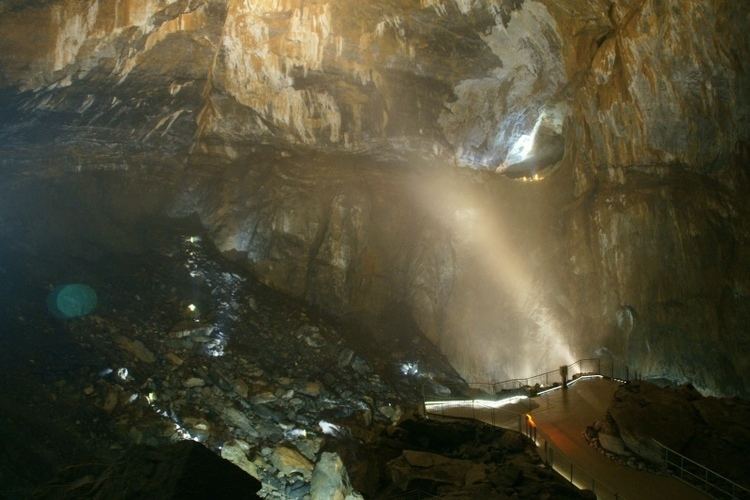Phone +33 6 37 88 29 05 | ||
 | ||
Address Espace accueil Arrakotchepia, Quartier Calla, 64560 Sainte-Engrace, France Similar Gorges de Kakuetta, Gorges d'Holzarté, La Falaise aux Vautours, Petit train d'Artouste, Grottes d'Isturitz et d'Oxocelhaya | ||
La Verna is a show cave in the commune of Sainte-Engrâce in the department of Pyrénées-Atlantiques in France. 660 metres (2,170 ft) of mined tunnel leads into the Salle de la Verna, the largest chamber in a show cave in the world. It has a diameter of 250 metres (820 ft), a height of 194 metres (636 ft), a surface area of 5 hectares (12 acres) and a volume of 3.6 million cubic metres (130,000,000 cu ft). A river cascades into the chamber from halfway up the east wall, and sinks into boulders near the base of the chamber.
Contents
The chamber was named after the Lyon scouts, La Verna Troop, who helped in the attempted rescue of Marcel Loubens who died following a fall during the 1952 explorations.
In 2003 a standard 4 person hot-air balloon was flown in Salle de la Verna.
Geology
La Verna is part of the 82-kilometre-long (51 mi), 1,410-metre-deep (4,630 ft), Gouffre de la Pierre-Saint-Martin and Gouffre des Partages cave system.]] Explorations still continue in this and in other systems within the extensive Pierre-Saint-Martin karst area where 13 underground rivers and a total of 250 kilometres (160 mi) of passages, chambers and shafts have been mapped.
Most of the Gouffre de la Pierre-Saint-Martin is formed by dissolution in Cretaceous limestones, and the main river reaches a base level where it flows over insoluble schists of the Paleozoic basement rocks. The Salle de la Verna has formed where the river flows off the schist onto Devonian limestone. Over time, the river found a route through the soluble limestones, leaving the original downstream river passage (the Gallerie Aranzadi) high and dry. The chamber was formed by a process of solution and collapse, beginning about 200,000 years ago. The unconformity between the Paleozoic and Mesozoic rocks is clearly exposed in the walls of the chamber.
The river flowing through the chamber originated from the infiltration zones on the 2,000-metre high (6,600 ft) limestone plateaus, and emerges at springs 1,500 metres (4,900 ft) lower, in the valley of Saint-Engrâce.
Fauna
In this mineral world lives a unique community of animals, adapted to the dark depths of the karst. They are small invertebrates, blind, and without pigmentation. The two most common species observed in La Verna are the Aphoenops loubensi and Aphoenops cabidochei. In order to survive, these insects need an atmosphere saturated with humidity. After fecundation, the female lays a single egg, out of which a small larva hatches. Contrary to insects on the surface, this larva immediately metamorphoses to an adult, without feeding. The biologist Michel Cabidoche studied these animals in the 60’s. Since the opening of la Verna to visitors, in 2010, a team of researchers of the French national museum of natural history, under the leadership of Professor Arnaud Faille, closely follows their evolution.
